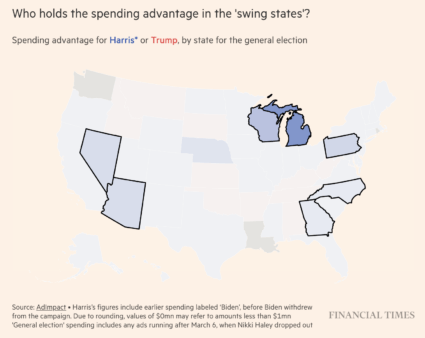With less than fifty days until Election Day, political advertising is entering its final stretch this fall. That means major fluctuations in ad spend and ad costs, making this a challenging time for brands looking to reach consumers in the run-up to the holiday shopping season.
As we head into Q4–the busiest time for ecommerce even in a normal year–the businesses that rise to the top will be the ones ready to adapt quickly to all the political events this fall. When it comes to paid search, your brand will be facing everything from skyrocketing costs to local election impact to sales slowdowns.
But never fear: you can still win with the right preparation. That’s why we’ve put together a guide to make sure your paid search strategy is ready for everything that comes your way this election season.
The price is right: stay ahead of the curve by monitoring ad costs
As November draws closer, you should be keeping an eye on any political events that might impact costs in the places where you advertise. You’re probably already focusing on the presidential election, but remember that local races and other events can also affect advertisers in the lead-up to November.
The presidential election is, of course, the biggest race to watch when it comes to advertising this year. We’re in the middle of the highest period of political ad spending: in the past, about 70% of political spending has taken place between July 1st and November 5th. And 2024 is poised to set a record as the priciest political cycle in history, with a projected total cost of $10.69B, according to AdImpact.
With so much cash flowing into advertising these days, it’s essential to keep up with fluctuations so you can adapt your strategy and make sure you’re still getting the best bang for your buck. A good way to keep on top of the latest news is via The Financial Times’ political ad spend tracker, which updates every six hours so you can monitor any major increases and/or decreases in spend. It also flags which campaign is spending more overall and in particular states.

Source: Financial Times
Beyond the presidential race, major local elections can also pack a punch when it comes to political advertising. Senate, House, and Gubernatorial races all differ state-by-state, so the impact on your strategy will depend on the areas you’re advertising in.
It won’t be enough to just understand state or national patterns; you need to dive deeper into more niche markets. Monitor for any shifts in ad spend within counties, cities, and districts to ensure your campaign performance is as strong as possible in those areas.
It’s not just political campaigns that can make a difference in advertising this election season. We’ve also seen that major current events play a role in political ad spend, which in turn drives YouTube CPM increases.
Looking back at July, we can see how some of the big political news stories impacted ad spend. For example, when Joe Biden’s campaign paused ad spend after the assassination attempt against Donald Trump in mid-July, CPMs stayed relatively flat day over day. But after Biden HQ resumed ad spend a few days later, we saw an increase in CPMs across retail brands’ YouTube campaigns.

Your team should be keeping close track of all of these factors in the coming months, or you risk wasting valuable ad dollars in inefficient places.
Performance predictions: keep an eye out for major changes in the coming months
It can be tough to predict performance in a rapidly shifting advertising environment like the one we’re seeing this election season. But there are some changes you can anticipate as November draws closer.
Keep in mind that you can’t rely on performance comparisons from the last presidential election cycle in 2020. Although comparing these two periods might have made sense in elections past, 2020 was an unprecedented year for everyone, advertisers included.
The pandemic led to factors like lockdowns and stimulus checks that drove unique consumer trends. Those months were a historical anomaly, so your 2020 paid search performance isn’t a reliable benchmark for 2024.
Instead, try looking at your fall 2016 performance, if possible. While 2016 may be far in the rearview mirror these days, it’s likely a more accurate representation of an election year baseline for your business than 2020 was.
You should also take your performance from August 2024 onwards into account. This period is useful because it shows what your performance has looked like so far since political ad spend increased after Kamala Harris secured the Democratic nomination.
Based on past election weeks, you should also anticipate a slowdown in sales the week of the election. Consumer spending dropped around 6% in the 2012 and 2016 election weeks, according to Epsilon. The good news is that spending seems to pick back up quickly as we enter the peak holiday shopping season with Black Friday/Cyber Monday.
While you may not be seeing as much PPC revenue in the first week of November as you have in non-election years, that’s not a reason to pull back on promo. Keep your messaging moving forward as expected so that when consumers jump back into shopping, your brand is top of mind.
Strategic success: adapting your paid search budget and strategy to win
As CPMs continue to fluctuate with current events, you’ll need to adjust your paid search strategy accordingly to stay on top. Rather than making a rigid plan months in advance, you need to react quickly to the latest updates to make sure you’re still spending efficiently. Now, more than ever, agility is key.
To win, you’ll need to reevaluate your geo-targeted strategy across YouTube and Demand Gen, taking the election into account. Is it worth keeping tactics like YouTube live in swing states where presidential political ad spend is expected to reach the all-time high?

Source: Financial Times
The states that will likely see the highest political ad spend (and the highest CPMs) in the coming months include:
- Arizona
- Georgia
- Michigan
- Nevada
- North Carolina
- Pennsylvania
- Wisconsin
If consumers in those states are your major customer base, pulling back from those markets may not be an option. But you should consider where you might be able to reallocate your budget to get a better value, whether that’s narrowing in on more efficient cities within those states or exploring different paid search tactics altogether.
You might see some big changes in the coming months, but with the right preparation and monitoring your brand can navigate the tumultuous election season and set yourself up for a successful holiday season.
Get ready for the long-term future of search with our white paper, The Game-Changing Power of AI.







Responses